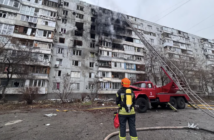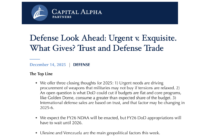Welcome to the CavasShips Podcast with Christopher P. Cavas and Chris Servello…a weekly podcast looking at naval and maritime events and issues of the day – in the US, across the seas and around the world. This week…We were in Tampa at SOFWEEK where we heard from special operations command leaders and spent time talking to companies who are bringing creative solutions to the SOF Maritime world. In the discussion portion of the show we will hear from the Navy Captain responsible for bringing those solutions to life and a few of the companies who showcased their technology at the four day show.
Please send us feedback by DM’ing @CavasShips or @CSSProvision or you can email chriscavas@gmail.com or cservello@defaeroreport.com.
This Week’s Naval Round Up:
Japan revealed on May 11 that a five-ship Chinese naval flotilla had sailed completely around Japan’s main islands from April 30 through May 11. The formation was led by the Type 055 destroyer LHASA. Also on May 11, Chinese President Xi Jinping released a letter he sent to the Chinese Navy’s submarine force urging them to strive to become an elite force as China builds up its Navy, now the world’s largest.
Bahrain-based US Fifth Fleet announced May 12 it is working with regional allies and partners to increase the rotation of ships and aircraft patrolling in and around the Strait of Hormuz. The move comes after Iran recently seized two civilian merchant tankers leaving the Persian Gulf. The US said that Iran has harassed, attacked or interfered with the navigational rights of 15 internationally-flagged merchant vessels over the past two years.
The second pair of Type 054AP frigates for the Pakistani Navy was delivered from Hudong-Zhonghua Shipyard near Shanghai on May 10. The new TIPPU SULTAN and SHAH JAHAN will join two sister ships delivered in 2021 and 2022.
Three civilians remain missing after the crash May 10 of a US Navy-contracted Phoenix Air Learjet 35 near San Clemente Island off the southern California coast. Although an extensive search was made for survivors and a debris field was located, the Coast Guard called off further efforts on May 11. The Phoenix Air Learjets are used by the Navy for a variety of training missions, including simulating cruise missiles, electronic attack and jamming and target-towing.
The destroyer OSCAR AUSTIN DDG79 is on an unannounced deployment and is taking part in NATO Exercise Formidable Shield off Norway. It is the first cruise for the ship in six years. The OSCAR AUSTIN suffered major internal damage in November 2018 when a welding fire broke out while the ship was undergoing a major overhaul at BAE Systems in Norfolk. The Navy investigation found numerous errors were made in combating the blaze. Repairs were lengthy and the ship didn’t return to service until late in 2022.
The US Navy has declared that its mine countermeasures mission package is operational. The system, intended to be used aboard littoral combat ships and other vessels of opportunity, consists of several components including an unmanned surface vessel carrying minehunting sonars, and airborne systems carried by MH-60 helicopters, all linked together by software aboard the controlling ship. Extensive at-sea testing was carried out aboard USS CINCINNATI, the Navy said. The first operational system ready to deploy won’t be available just yet, and the first deployment aboard ship is expected to take place early in fiscal 2025.
In new ship news, the commissioning ceremony for destroyer LENAH SUTCLIFFE HIGBEE DDG123 will take place May 13 at Key West, Florida. The ship, the last Arleigh Burke-class Flight IIA destroyer delivered from Ingalls Shipbuilding, will be homeported at San Diego.
And the first Expeditionary Medical Ship will be named USNS BETHESDA (T-EMS 1), Navy Secretary Del Toro announced May 12. The ship is a variant of the EPF expeditionary fast transports built by Austal USA in Mobile, Alabama. The Navy is expected to buy at least two EMSs, which are essentially seagoing ambulances rather than full-sized hospital ships like the existing MERCY and COMFORT.
Cavas Squawk:
Today I’m going to talk about Vietnam. First off – I did not serve in the Vietnam War, but during the entire conflict I was growing up and coming of age. I was a foreign service kid, both my parents worked for the US government, many of my friends were military kids. At first everyone I knew supported the war effort. Eventually the big kids I knew began to go off to war. And of course some never came home.
Gradually the country turned against the war, seeing no end to it. Especially after the January 1968 Tet offensive, when the ferocity of the conflict really came home.
It was an odd war in that people went, they served their tour, and most rotated stateside. There was no big group coming home, as after World War II, when most of our fathers served on active duty. People didn’t like the war, didn’t want to talk about it. Vets didn’t want to brag about it. Quite the opposite – the usual thing we heard was just how f-upped it all was.
The country, of course, was deeply divided around many issues. The war was a big part of it but it was not just that. The civil rights movement was in full swing, desegregation efforts and racial issues struck society at all levels. The culture war back then was the clear divide between us younger folks – hippie freaks, longhairs, the counterculture – and our parents, the people who fought the Big War and didn’t quite understand their much hairier rock’n’roller kids.
I remember a Saturday evening in May of 1971. I was in a band, we played a job but it ended early, and my buddy Paul and I drove into DC where the huge May Day anti-war protest rally was taking place. More than 40,000 people were camped out in and around West Potomac Park near the Washington Monument. It was an incredible night, almost like a movie, full of counterculture vignettes which I won’t bore you with here. But one scene always stuck with me.
We were sitting near the Washington Monument some time around midnight. A young Army soldier showed up, dressed in his best Class A uniform and carrying a duffelbag. He was just back from Vietnam, had flown into National Airport, and came over to see what was happening.
People surrounded this soldier. They shook his hand, clapped him on the back. Girls hugged him. All I heard people say was “Welcome back to the world, man!” I heard and saw nothing negative. Far from it.
I know that was not a universal experience, and what you’ve mostly heard have been stories about vets coming home to very different receptions. Some of that no doubt happened. But it was true that most people on all sides just wanted to forget about it.
All that has completely turned around today, especially after 9/11. The phrase, “Thank you for your service,” is often well-meaning and sincere and at the same time a cliché. But the roots of the need for that thought to be said are in the Vietnam experience.
This week marks a major Welcome Home event on the Mall in Washington DC, literally on the very same grounds where the May Day protest took place. It’s also the same ground that many other protests took place, including Resurrection City in May 1968, another event I clearly remember.
But this time the gathering is an effort to finally give Vietnam Vets the welcome home they deserved. The overwhelming majority of them didn’t volunteer to go, but go they did, because their country asked them. In the greater context of things this week falls far short of what should have happened, but it is an official recognition that, in the words of Korean War veteran Howard William Osterkamp, All Gave Some, Some Gave All – and we owe you.




